September 30 (Monday)
We visited Thai-Japan Institute of Technology and Thammasat University. Both are partner universities of Josai. The general academic agreement with Thai-Japan Institute of Technology was signed in 2015, and with Thammasat University in 1984. In both cases, we were welcomed by the presidents, staff in charge of international exchange, and faculty members with close ties to Japan.
Tai-Japan Institute of Technology is a private university that was founded in 2007 as the predecessor of the Tai-Japan Technology Promotion Association, which had been active since the 1970s as a training organization for Japanese-style manufacturing technology, and received approval for its establishment. The university has approximately 4,000 students and boasts a consistent 100 percent employment rate, with a certain percentage of graduates working for Japanese companies. President Bandhit Rojarayanont is a graduate of the Tokyo Institute of Technology and is fluent in both English and Japanese. He also listened to a lecture by Jiji Press. He shared his thoughts from a broad perspective, ranging from manufacturing to AI, and from political issues to social changes in Thailand. In Thailand, the population of 18-year-olds has begun to decline in recent years, and the percentage of students who go on to university has reached a plateau. Some universities in the country are "selling themselves" to China. For the future development of Thailand, it is essential to re-educate and train not only 18-year-olds but also those who are still working, but the government's support is not enough to encourage companies to take this step. He also expressed concern about the large number of immigrants who do not have nationality or access to education. I told him that this is an issue that Japan must also face and overcome in the future. We had a very interesting conversation. Professor Kazuo Hana, who accompanied us, introduced IIST (Institute of Integrated Science and Technology), the English-language program of the graduate school of science Graduate School of Science and Engineering technology at TUFS, and showed a video message from the students to the president of TUFS. Afterwards, Professor Hana also gave a presentation on IIST to the students.
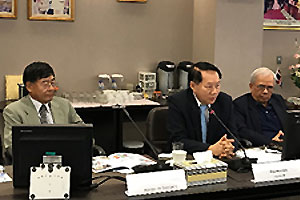
Mr. Koichi Mizutani, an alumnus of IIST Faculty of Sustainability Studies M.S., Faculty of Sustainability Studies ), works in the President's office at Thai-Japan Institute of Technology and was instrumental in organizing our visit and the Hosei meeting. After working for the Thai-Japan Technology Promotion Association for a long time, when he began to feel the barriers of Thailand's academic background, he learned about an entrance examination for working adults in Faculty of Sustainability Studies TUAT and enrolled in the program with a strong desire to enter. He then "studied" in Japan for six years until he completed his master's degree, and then returned to Thailand to work at the university, which had just been established.
In addition, Mr. Hideo Yoshihara, an alumnus of the university who serves as an advisor to the president, was present at the Hosei meeting as well as at the visit to the university on this day. He is involved in matching graduates of the university with Japanese companies. He also participated in the "50th Year Entrance Ceremony" at the Budokan in April this year.
Thai-Japan Institute of Technology and our university have not yet signed a student exchange agreement. This private university has built a unique position in Thailand, and there are several people with ties to TUT in very influential positions, all of whom seem to be eager for stronger ties with TUT. I hope that this will lead to a stronger connection in the future.
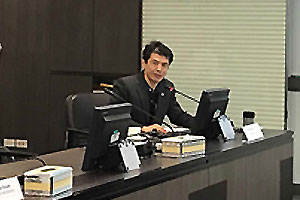
Thammasat University President Gasinee Witoonchart is a woman, the first woman president of a university in Thailand since the 1980s, and it is not unusual to see women presidents of comprehensive universities in Thailand. The university also upholds the philosophy of being a university for democracy, justice, and freedom. After the introduction, which included an explanation of the university's charter, we discussed the similarities between the university and Thammasat University in terms of their origins in legal education and the ideals that they both aim to achieve.
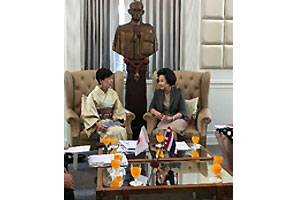
We also had a chance to talk with a student from Faculty of Global and Interdisciplinary Studies who is currently studying abroad at Thammasat University. He is studying Southeast Asian countries. Many students from Malaysia, Vietnam, and other Southeast Asian countries are studying there, and they enjoy the exchange and have a fulfilling school life. They came to us in their nice uniforms on this day, as they are supposed to wear their uniforms during the examination period. Thammasat University also has programs in Indian Studies, Chinese Studies, and Thai Studies taught in English, and we feel that it is truly committed to becoming a central university in Asia. As a private university, Thammasat University has a history of being at the forefront of the democracy movement and was incorporated into a national university after a fierce campaign. Even today, it remains at the center of freedom of speech and democratization in Thailand.
In attendance were the President, the Director of the International Exchange Section, an Associate Professor of Japanese, the Associate Dean of the College of Liberal Arts, and the Associate Director of the International Division. Dr. Puli, who stayed at Hosei for a research stay, also attended the meeting.
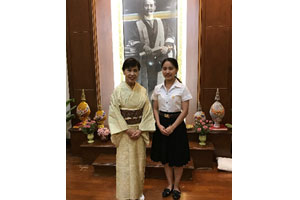
The main topic of discussion was the lack of exchange students from Thammasat University to Hosei over the past five years. One student from Chulalongkorn University in Thailand comes to Hosei every year. Is there a possibility of a double degree or joint degree? He explained again about the ESOP (exchange student acceptance program) and other matters. Today's discussion focused on the liberal arts and social science faculties, as they are located in the city, but tomorrow, Dr. Hana and the IIST promotion team will visit the Faculty of Engineering at Thammasat University's other suburban campus to make further contacts.
September 29 (Sun.)
We toured the city of Bangkok.
I have been to China, Indonesia, India, Vietnam, Myanmar, and Laos several times, but in Thailand, I visited Doi Tung, a northern mountainous area where ethnic minorities live, in 2000. At that time, there were 26 villages of seven ethnic groups, including the Akha, Karen, Lahu, Lisu, Mon, and Mien. There was a Doi Tung project by the royal family to change opium cultivation to agriculture and handicrafts, and I went there to cover the project at the request of a magazine. At that time, I also covered textiles in Chiang Mai and its suburbs.
In 2003, while traveling by boat along the Mekong River through Laotian territory, I entered the villages of the Laorum, Lu, Kham, and Hmong tribes. He was able to observe the same cotton cultivation, cotton ginning, and dyeing and weaving as in the Edo period. From there, we moved to Chiang Saen, where we traveled by boat and elephant to the villages of the Karen, Lahu, Akha, and Yao tribes. In those trips, Bangkok was just a stopover or a passing place, and we did not spend much time there. So this time, we took our time to visit temples and royal palaces.
I discovered something important. That is, Thai culture is a mixture of Indian, Sri Lankan, Cambodian Khmer, Myanmar, Laotian, Chinese, and European cultures. The architecture of the Royal Palace is a particular expression of this, with all styles coming together in harmony. There is also European architecture with Thai-style roofs. Even today, many people from Myanmar and other countries enter Thailand and come to Bangkok. Thailand has always been a country of diverse ethnic groups.
Saturday, September 28
The main event of the trip, "Hosei Meeting in Bangkok," was held on the same day. About 40 alumni and 60 family members attended the meeting. Three current students who were studying abroad at a Thai university or doing a long-term internship at a Japanese company also participated. Many of them are temporarily residing in Thailand with Japanese companies, and many of them have small children. However, there are also those who have put down roots and are living anywhere in the world. In Thailand, several people in their 30s and 40s have started their own businesses and are running them by themselves.
One of them is leading a gathering of alumni and alumnae, and the circle has already grown to about 30 people. In order to make this an official organization, a proposal was made during the meeting to start a branch of the Alumni Association, which was supported by the participants. The Alumni Association's activities are expected to go into full swing in the future as it further expands its circle to include alumni in Thailand.
One person who graduated from the Faculty of Social SciencesFaculty of Law but became a certified public accountant, spun out from a major Japanese auditing firm and moved to Thailand to open an accounting firm for Japanese companies, and a young man who graduated from the Faculty of Social Sciences was dispatched by a Japanese company he worked for to take charge of a logistics section in the Myanmar/Thailand border region, a position he has held for three years. He is now in his third year in charge of a logistics section in the Myanmar/Thailand border region, and is a young man in his third year in this position.
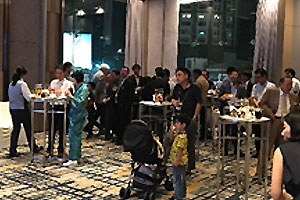
September 27 (Friday)
This was the fourth time that Jiji Press held a lecture at its "Top Seminar," following London, New York, and Los Angeles. Jiji Press has been conducting "Top Seminars" in each of the places where Hosei Meetings have been held, and I have been given opportunities to speak at these seminars in conjunction with my visits. This time, the 200th anniversary of the Top Seminar in Bangkok (it has been going on for about 30 years) was a special event, so about 100 top executives of Japanese companies and government officials gathered for the event. Normally, the seminar is a lunchtime lecture meeting, but this time it was held in the evening and there was a standing buffet party, making it a special event. After my lecture, Mr. Shiro Sadojima, Ambassador of Japan to Thailand, gave a talk on recent economic and political developments in Thailand-Japan relations for the participants, which was followed by a dialogue. We had a fruitful discussion on Thailand's richness of technology and skills, and the activities of women, starting with the method of innovation in the Edo period.
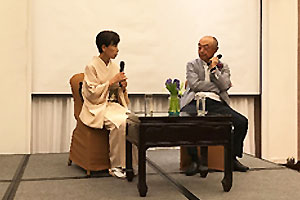
September 26 (Thursday)
This year, the annual Hosei Meeting overseas will be held in Bangkok, Thailand. So, I left Japan on this day. Hosei Meeting is a gathering of alumni abroad with the university. Some of them are already organized as alumni associations, while others are not yet, but the purpose of the meeting is to create an opportunity for them to get together by informing the local Japanese media about the President visit and to help them organize their own alumni associations.
In the evening, five members of the university and Mr. Hidemitsu Kuwano, Advisor to the Alumni Association, arrived at Bangkok's Suvarnabhumi International Airport. This year again, thanks to Advisor Kuwano's consideration, the president of Akebono Brake (Thailand) Co.
There are more than 70,000 registered Japanese residents in Thailand, with more than 40,000 in Bangkok alone. (The population of Thailand is approximately 70 million, and the population of Bangkok is 8 million.) Since there are many Japanese residents who do not register, the actual number is probably much higher.
In Thailand, it is common for women to work full time, and although some consideration is given before the birth of a child, they return to work immediately after the birth. It is not unusual for some to become managers. Since childcare facilities are expensive, they are raising their children in a variety of ways, including leaving them with their parents back home to work, having their parents or husbands who live with them look after them, or leaving them with neighbors.
September 25 (Wednesday)
The Executive Trustee Meeting was held. A meeting of the Executive Trustee was held. The Trustee meeting was also held afterwards. Finally, a meeting of the Councilor was held to discuss budgeting policy.
September 24 (Tuesday)
An expanded meeting of school principals was held.
After that, the "Agreement Conclusion Ceremony for the Promotion of Sustainable Development Goals (SDGs)" between the town of Shimokawa, Kamikawa-gun, Hokkaido and Hosei University was held. Shimokawa Town has incorporated the Sustainable Development Goals (SDGs) into its top-level plans, the Comprehensive Plan and the SDGs Future City Plan. In June 2018, the town was selected as an "SDGs Future City" and a "Municipal SDGs Model Project.
Meanwhile, in December last year, Hosei University issued the " President Statement on SDG Initiatives at Hosei University". The statement calls for "providing society with knowledge and solutions that support the achievement of the SDGs," "fostering human resources with the ability to work toward the achievement of the SDGs," and "collaborating with a variety of partners. This is the first agreement with a municipality dedicated to the promotion of the SDGs. We are particularly looking forward to exchanges among students. The number of students who enter Hosei University is disproportionately from the Tokyo metropolitan area. We would like to see more students from Hokkaido enter the university. In addition, students from Hosei University have already stayed in Shimokawa Town and experienced an internship there. For students from the Tokyo metropolitan area, the experience in rural areas will be an asset for them in the future. I think there is a need for a system within the university to enable students to make their experiences in rural areas, volunteer work, peer-net activities, and SDGs efforts as outcomes of their seminars and classes.
September 20 (Friday)
A meeting of school principals was held. The HOSEI 2030 Steering Committee meeting was then held.
September 19 (Thursday)
The November/December issue of the public relations magazine "Hosei" featured a roundtable discussion with Hosei University students. The four participants were Tomohiro Nishimori, who is active in the Hosei University Newspaper Society, Yuta Fujiyama, a student staff member of the Ichigaya Volunteer Center (VSP), Ai Konagai of Team Orange, and Marina Yokomizo, a staff member of the Extracurricular Liberal Arts Program Project (KYOPRO). They are the students who were instrumental in the 55/58 Farewell Days and the 3-Campus Bus Tour. As a faculty member of the Tama Campus, I have not been able to have classes or seminars since I became President, and it is difficult for me to walk freely around the campus by myself. Society is changing rapidly, and so are the students, and I really want to experience that firsthand. This roundtable discussion was a great benefit for me. All four students, despite their uncertainty, took a step forward, which opened their eyes, and from there, they all took actions to connect their interests to the outside world. They are not confident by nature, but they have the courage to act, practice, and verbalize their actions. All of the students were connecting their extracurricular activities to their intellect in lectures and seminars. Certainly, Hosei University is a place where this is possible. We hope that the publication of this roundtable discussion will be edited to convey the enthusiasm of the day in order to encourage other students.
After the meeting, I was interviewed by the Hosei University Newspaper.
After the meeting, the deans' meeting was held. After the Dean's Meeting, a workshop on data science was held.
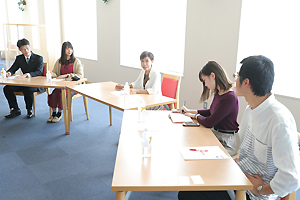
September 18 (Wed)
Today, the University Evaluation Office received the University Evaluation Report for 2019.
Three Executive Trustee Meetings and three Executive Trustee Roundtables were held. The University-wide Quality Assurance Conference was also held.
September 17 (Tuesday)
At the Tokyo Metropolitan Government Office, I met with Tokyo Governor Yuriko Koike and handed over a "Proposal for Water Quality Purification of the Outer Moat and Nihonbashi River and Conservation and Restoration of Tamagawa Josui and its Diversion Network" jointly signed by Presidents of the three universities, Yoichiro Matsumoto (President of Tokyo University of Science) and Norihiko Fukuhara (President of Chuo University). The three universities, whose campuses are located along the outer moat of Edo Castle, have been conducting research to improve water quality. At the same time, they have been working together with local high schools, neighborhood associations, and businesses to preserve and restore the waterfront area. The first is to position Tamagawa-josui, the outer moat, and the Nihonbashi River as green infrastructure that plays a role in purifying water quality, improving water circulation, securing water resources for disaster prevention, and preserving and revitalizing natural history and culture by introducing river water from the Tama River to the rivers. Secondly, the water quality of the outer moat, which will be the marathon course for the 2020 Tokyo Games, and the Nihonbashi River, which is undergoing redevelopment along its banks, should be promptly improved by allowing river water to flow through them on a trial basis. Third, a committee, etc., should be established to gather the knowledge of universities, research institutes, and citizens (organizations) and to collaborate with them in studying the improvement of water quality and maintenance management of these water systems.
In other words, return the outer moat to a "flowing river" as it was in the Edo period, and restore the "city of water. The Sumida River is also quite different from the Thames in London or the Seine in Paris. The embankments are too high to see the water. Tokyo, a world city with global warming, needs water.
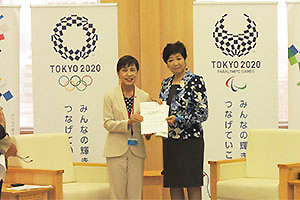
The Preparatory Committee for the opening of the Museum was held. The museum space is now quite visible. Signage will be installed. The system will allow visitors to access information by touching the screen. I am very much looking forward to it.
September 6 (Friday)
Attended a meeting of an off-campus company.
September 5 (Thursday)
The secretary general of the Open University of Japan came to the office to request the appointment of a new Trustee and Councilor the Open University of Japan for the new fiscal year starting October 1.
Mr. Fujita of Mitsubishi Corporation visited our office. He requested to be appointed as a Councilor "Mitsubishi Mirai Nurturing Foundation.
Mr. Fujita attended a meeting of the Branding Promotion Team. The staff of the promotion team has been replaced by a new generation. At the meeting, I talked about the branding process of the university. I have already written about this in the morning edition of the Nihon Keizai Shimbun (7/1/2019). The branding process has been carried out with the help of the faculty of Faculty of Social Sciences, outside companies, and the faculty and staff, including the President office. I would like to leave this process as an important record.
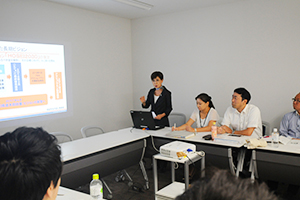
September 4 (Wed)
Executive Trustee meetings and meetings were held.
September 3 (Tuesday)
Mr. Kengo Suganuma, the new president of the Tokyo Shimbun newspaper, visits the office. He is a close friend of the Tokyo Shimbun. Mr. Suganuma has a close relationship with the Tokyo Shimbun and used to write a series of articles for the paper. He is also a long-time subscriber. I also have fond memories of a symposium we co-hosted with the University's Okinawa Culture Research Institute, at which the late Okinawa Governor Takeshi Onaga gave a lecture at the University. This time, I was asked to write a series of 10 articles in the New Year. Apparently, it was not just a greeting.
A farewell party was held at the Sky Hall on the Ichigaya Campus for former Acting President Toyokichi Onizuka, who passed away the other day. Hosei University was in the midst of a series of major events in the 1980s, including the relocation to Tama, the sale of the Kawasaki campus, and the reorganization of the President.

In 1988, with the inauguration of President Moji Ari, the Hosei University Trustee also began to improve the university organization. Toyokichi Onizuka, then Trustee Hosei University, President Moji Ari as Acting President at the end of his term and later as Acting President, taking overall direction of Hosei University. He fulfilled a very important responsibility. Each of the President and Trustee Hosei University has supported the university in his or her own time by taking responsibility for the university. We must carefully pass on their thoughts and feelings to the next generation. I heard that the seminar students of past generations had long held a gathering, and many seminar alumni gathered there. His wife also came with her relatives. She used to be a pharmacist and got acquainted with Dr. Onizuka when she was in the Faculty of Pharmaceutical Sciences at the University of Tokyo.
September 2 (Monday)
The President Cup Golf Tournament was held again this year, and the trophy was handed to the winner. It was a very hot day, but we are glad that it ended without incident.
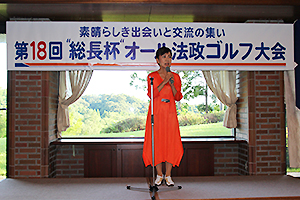
September 1 (Sunday)
I took a break from the President Journal in August, resuming it in September, and although there are usually fewer meetings in August, I traveled to various sponsor meetings, including those of the Trustee deans. In addition to my off-campus speaking engagements and TV appearances, I had such a busy schedule of manuscripts that I had to write a little each day to make it in time. September came and went, with some things yet to be finished.
In August, I received news of one of our alumni's finalists for the International Literary Award: Kunio Yamagishi, a 1967 graduate of Department of Economics my alma mater who now lives in Canada, has published a novel, "The Return of a Shadow," about the internment of Japanese Americans in Canada during World War II. He was informed that his novel was one of the eight finalists for the Rubery Book Award, a prestigious international literary award based in the United Kingdom. Although she narrowly missed out on the prize, she was chosen out of thousands of entries.
Mr. Yamagishi worked as a researcher at the Consulate General of Japan in Toronto, then in investment banking on New York's Wall Street, before retiring to write in Canada.
President I have often met alumni who are more senior than I am, who are active overseas, and who are also developing their work abroad. The international activities of Hosei graduates is not a new trend. I would like today's current students to know that opportunities to work around the world are expanding.

